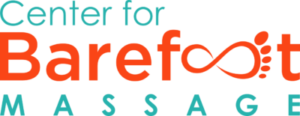One step at a time with Barefoot Massage
As massage therapists, we are intimately acquainted with the physical toll our profession can take on our bodies. Repetitive strain injuries, particularly in the upper extremities, are a pervasive challenge, affecting nearly 65% of therapists, with over 80% feeling vulnerability in their hands. Regardless of the injuries we treat, it’s inevitable that massage therapists will encounter their own at some point in their careers, often stemming from repetitive motion, poor body mechanics, or unknowingly acquired habits.
Barefoot and Ashiatsu practitioners are not exempt from these challenges. During a recent instructor meeting at the Center for Barefoot Massage, my colleagues and I engaged in a candid discussion about the injuries we’ve experienced and observed in our practices, staff, and classrooms. While most of our instructor team had encountered massage-related injuries in the past, the adoption of CBM’s techniques, approach to body mechanics, thinking processes during work, and the use of the strap proved transformative. Notably, not a single instructor has suffered a Barefoot Massage-related injury since making these changes – and all of our instructors maintain a full schedule of clients in addition to teaching.
However, all of our instructors observe movement restrictions or imbalances in students, particularly those previously trained in Ashiatsu before ever attending a Center for Barefoot Massage class. There are some common overcompensating movements, and translation of gravity habits that typically need tweaking. The potential for injuries if the issues were not addressed became evident. The solution? Adopting CBM’s approach to how we use our feet and body during barefoot massage sessions: utilizing tools such as straps, stacking, not pushing, pulling or lifting, and alignment ergonomics for the myofascial techniques in ways that prevent overexertion. This approach allows therapists to work smarter, enhancing service quality and contributing to better health outcomes.
In the quest for injury prevention, small adjustments to technique can make a monumental impact. Learning and practicing good body mechanics are paramount, especially when dealing with chronic repetitive motion injuries. The improved body mechanics taught in our classes were developed as a direct result of our instructors watching their staff work with their feet daily and see where the restrictions and common issues arise. By embracing newer techniques, the risk of injury can be significantly reduced. It is crucial to prioritize body care and use proper techniques to ensure a successful and enduring massage therapy career. Many of our instructors have been massage therapists for over 20 years: we attribute that to not only Barefoot Massage, but also constantly evaluating the approach to Barefoot Massage.
The Center for Barefoot Massage specializes in a unique approach to Ashiatsu Barefoot Massage through our live Continuing Education classes. We emphasize anatomy and technique, teaching professionals how to provide therapeutic relief and prevent injuries both in themselves as well as their clients.
Our philosophy centers around the “Give it weight, then wait” theory, a pivotal aspect of our barefoot massage approach, targeting the Neuromyofascial web. Our “FasciAshi” technique involves working with fascial integration, navigating muscle and bone contours, and applying broad, consistent pressure at varying angles to address the body as a functional whole. Progressing through our courses, you’ll grasp the significance of sustained pressure and anatomical specificity to impact clients’ interoception.
Our Myofascial Barefoot Massage technique transcends the ordinary – it’s a dance of pressure, broad strokes, and efficient deep tissue work that sets your practice apart. Under the guidance of our expert instructors, you will learn how to use your feet to deliver controlled deep-tissue work with minimal strain, reducing the risk of overuse injuries on your joints, and tissues. Our classes focus on balanced weight distribution, and stability, and incorporate overhead bars and a suspended overhead strap to ensure proper body mechanics, making your practice more sustainable and effective.
Integrate Barefoot Massage with traditional techniques like deep tissue and trigger point therapy or cupping, and unlock a world of possibilities. Our classes offer a refreshing perspective on traditional techniques, enhancing efficiency and effortlessness. The Center for Barefoot Massage is committed to providing education on proper body mechanics, ensuring your practice is sustainable and effective. Our Barefoot Massage technique seamlessly integrates into preventive measures, promoting better posture and reducing strain.
With Barefoot Massage, you elevate your self-care practices, boost physical resilience, and become part of a community that celebrates the power of this transformative technique. The life of a massage therapist is undoubtedly challenging but armed with the right tools, techniques, and mindset, you can overcome obstacles and flourish. Join us at The Center for Barefoot Massage and embark on a journey that promises to revolutionize your approach to massage therapy.
How can I prevent injury to myself as a Barefoot Massage Therapist?
Stay tuned for our March 2024 blog series, this year’s edition of our annual ‘Barefoot Massage Open Challenge!’
This year’s topic for the “Open” is on common physical imbalances of Barefoot Massage Therapists that could result in injury. We’ve got tips and tricks, videos, exercises and food for thought content for everyone that will help your body be ready and pain free to give a long career full of barefoot massage sessions!

Written by Missy Anderson-Fritch
San Luis Obispo, California
She teaches FasciAshi Fundamentals, and the Intermediate (Supine/Sidebody) class.

Please note: we reserve the right to delete comments that are offensive or off-topic.